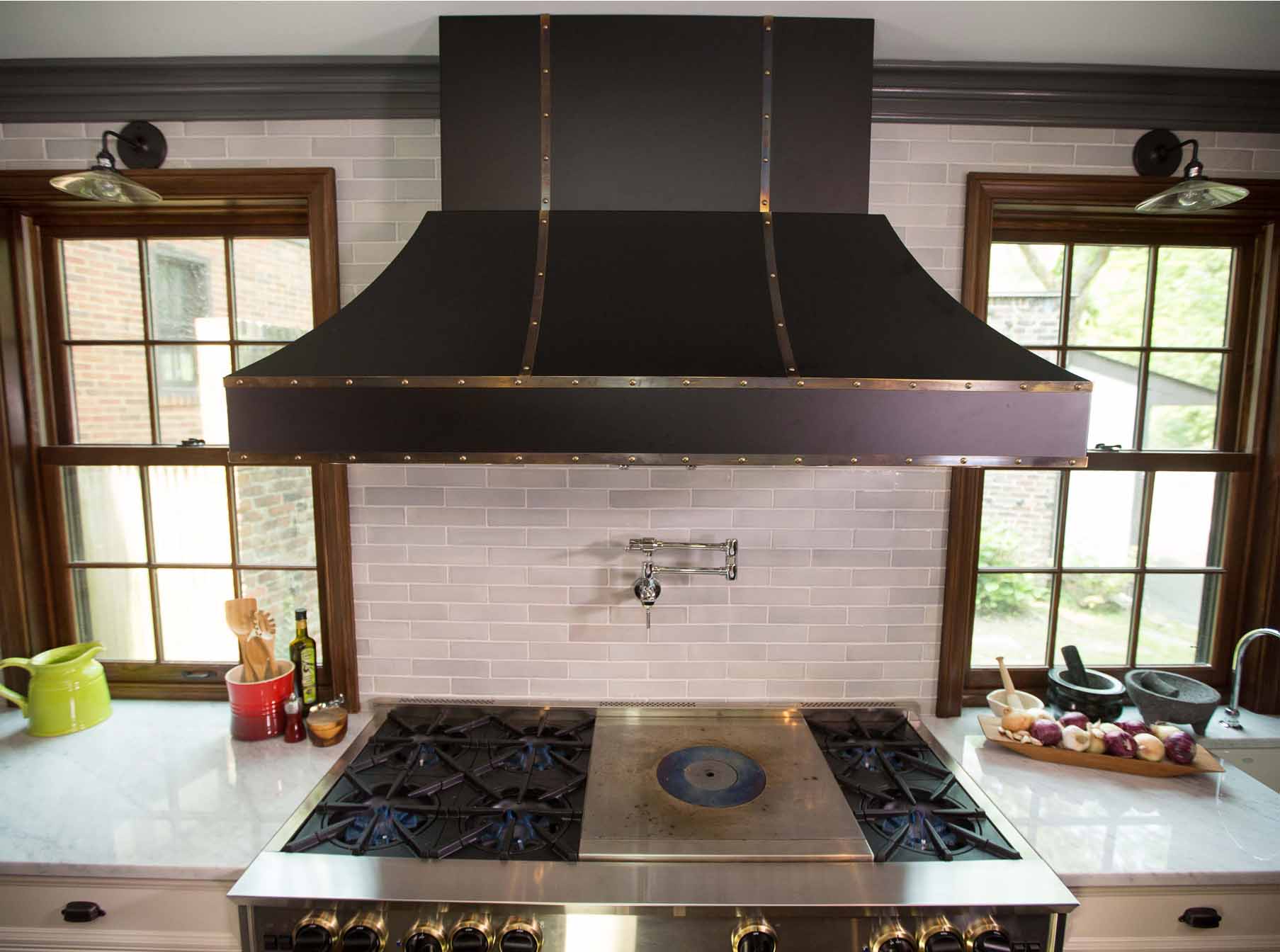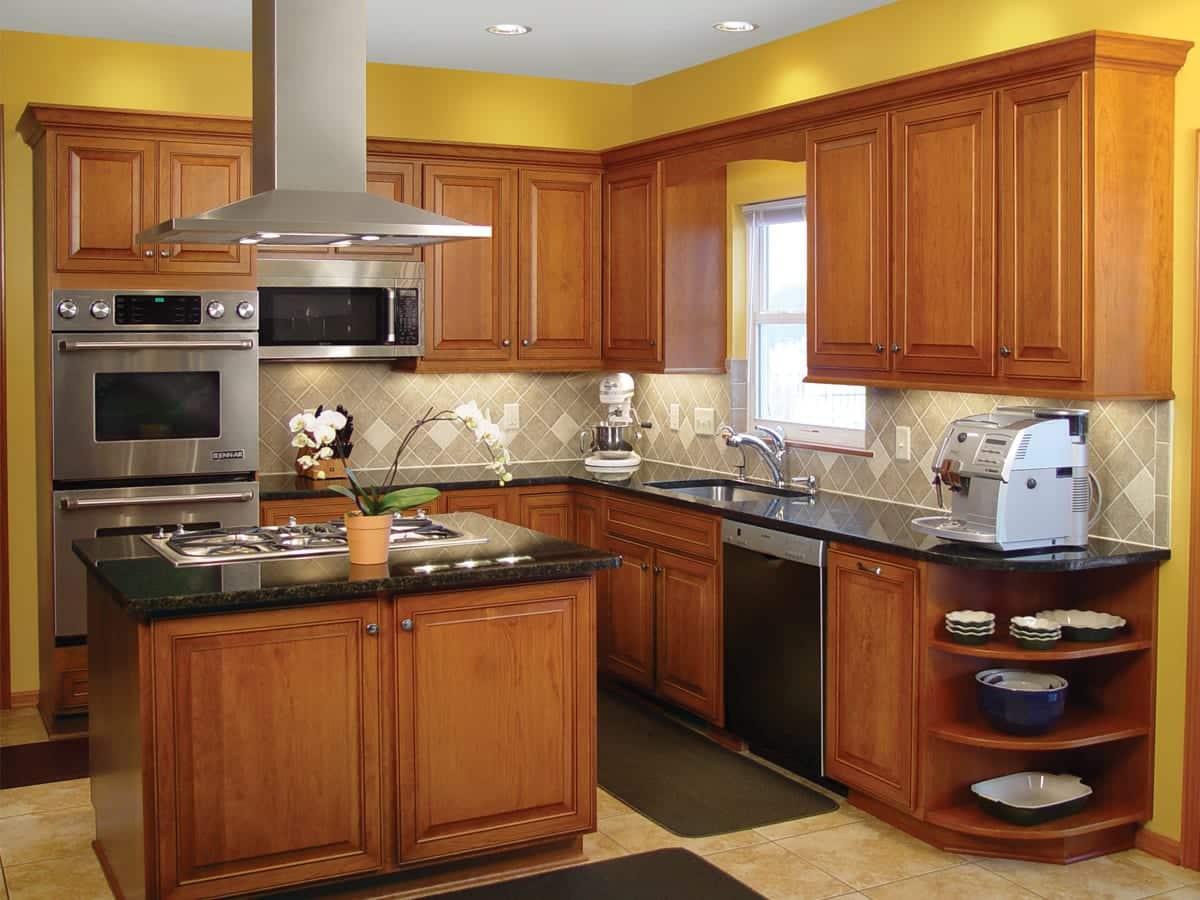Cooking can lead to air pollution generated by heating oil and other food ingredients. Therefore, you need to ensure your kitchen is well-ventilated to avoid breathing in unhealthy air. So, you may have to select between a ducted vs. ductless range hood for better air quality in your kitchen.
When you’re planning to buy a new range hood, choosing the type of hood becomes one of the most confusing things to do.
What Is a Range Hood?
Image credits; kitchenaid.com
The enclosure over your cooking range is known as a range hood. It usually comes with a fan and swallows the smoke, steam, and even other particles in the air produced during cooking.
They also add extra ventilation to your kitchen and filter out everything that comes off your stove and pulls it away from your food and you. It also pulls it away from your walls, ceiling, and other surfaces, keeping your kitchen clean and hygienic.
What Are Ducted Range Hoods?
As you might have understood, ducted hood ranges come with a duct fitted in the product. This moves the smoke and other particles from our kitchen. However, some of the kitchen designs in India might not be suitable for their installation.
If you pick this range hood, you need to ensure that proper ducts have been installed in your kitchen that will completely remove the dirt and smoke pollution.
What Are Ductless Range Hoods?
The ductless range hoods are models that can be installed in whichever kitchen type you choose. The size of your kitchen doesn’t matter; adjusting your home exteriors is not required as they come with no ducts. They operate by clearing out the air they continuously take in.
Image credits: prolinerangehoods.com
Most of them come with activated charcoal that helps remove foul odors, smoke particles, and other pollutants from the air, which are released back into your kitchen to recirculate.
Like ducted range hoods, cleaning and changing the activated charcoal filters within the product at least twice a year is essential. This maintenance will allow the range hood to work more effectively and with efficiency.
How Do Ducted and Ductless Range Hoods Differ in Extraction?
Let’s start with the ductless models, which forcefully take in the air and filter them out. They reduce the airflow, and during the recirculation mode, it will help extract at least 30% of air than when you have ducted out.
Two things affect the extraction of the ducted range hood: the type and length of the ducting and the number of bends. It will be more efficient if the ducted hood has a shorter ducting run.
You are ensuring that it will extract more air from the kitchen as compared to the longer ducting run. In the same way, when a range hood has fewer bands, it has a better performance than that which has more bends.
The Pros & Cons of Ducted and Ductless Hoods
We shall look at the benefits and downsides of ducted and ductless hoods below for your reference so that you can make an appropriate choice for yourself:
1. Ducted Hoods: Pros
These hood types are generally found in more extensive ranges and commercial kitchens with significantly more fumes, smoke, and dust particles. There is constant dirty air to deal with, which needs to be vented out for better air circulation.
a) Better Air Quality
Ducted range hoods have more powerful fans, making them move more air at once. So, ducted range hoods provide better air quality and even a cooler kitchen. A powerful fan speed always leads to a better ventilation system that helps with removing nasty odors and excess heat.
b) Silent Operation
A ducted range hood comes with external motors that you can mount on the roof or external wall. This ensures that the motor noise remains away from your space.
c) Efficient
A ducted range hood is more efficient and works incredibly by removing odors and other airborne particles from your kitchen.
Many buyers believe that these hoods work far more efficiently and have fewer complaints of noise as well. However, this is debatable, as many factors, including brand, model, size, and maintenance, can influence noise and efficiency.
Cons
a) Needs Professional Installation
Installing a ducted range hood requires many modifications, including cutting walls, installing blowers, and laying ductwork. This means the range hood can only be installed by a professional.
b) More Expensive Upfront
Installing ducted range hoods can be expensive since you will have to modify some spaces in your home.
c) Not Ideal for Some Homes
Sometimes you may be unable to install a ducted range hood depending on the size of your cooking area and the layout of your home. If the kitchen does not have external facing walls or the apartment does not allow extensive modifications, you will probably be unable to install a ducted range hood.
2. Ductless Range Hoods:
Pros
a) Does Not Need Professional Installation
The best ductless range hoods do not require any modification of the walls or installation of an exhaust duct. So, they are easy and hassle-free to install, and you don’t even need a professional to do the job. Homeowners can even install some models.
b) Can Be Used Anywhere
A vented range hood does not need ductwork installation like ducted models. Your kitchen also does not need to have an external facing wall. This allows them to be installed anywhere, be it an apartment, your home, or even a residence.
c) Cost-Efficient Upfront
Installing a ductless range hood does not need you to modify the kitchen or lay the ductwork. This makes it more cost-effective to install ductless range hoods.
If you would like a range hood that can be installed anywhere and is a little more versatile in its functioning, then you can go with ductless range hoods. These hoods function on a fundamental rule of filtering and recirculating air from your kitchen.
If you consider this factor, ductless hoods can seem far more convenient than ducted hoods, at least when it comes to the installation process of it all. You can also program many of these ductless range hoods as they come with timers. You can automatically set them on or off as they detect odors or smoke.
Cons
a) Doesn’t Remove Contaminants Effectively
When working with ductless range hoods, the air is returned to the kitchen other than being vented outside. This makes such range hoods less effective in removing smoke, odors, steam, airborne particles, and other particles suspended in the air.
b) Needs Frequent Filter Replacement
A ductless range hood uses activated carbon filters that trap smoke, food particles, grease, and other byproducts of cooking. Such filters need frequent maintenance and replacement. The more you use your ductless hood, the more frequently you’ll need to replace the filters.
c) Louder
Ductless range hoods are entirely self-contained, making them noisier than ducted ones. The blowers are located inside the unit rather than outside or within the ducts. This, in turn, makes them louder.
d) Raises Kitchen Humidity
Moisture and steam build up in the kitchen as the dirty air is recirculated and not vented outside. This leads to an increase in kitchen humidity levels as the filtered air still contains moisture.
e) Not the Best in Dealing with Heat
Ductless range hoods are poor in dealing with high heat. This is because self-contained hoods cannot dissipate heat effectively. Ductless range hoods normally absorb all the heat from the stovetop, which accelerates wear and tear on the unit.
What to Consider When Buying a Ducted Vs. Ducted Range Hoods
When you consider buying either a ducted or a ductless range hood for your kitchen, there are several features and other factors to consider. Some of them include the following;
a) Exhaust Type
Image credits: mkremodelinganddesign.com
As we already mentioned, ventilation systems come in two types that you can select when buying a range hood. Check below for their advantages and disadvantages to ensure you make the best choice.
b) Range Hood CFM
Cubic feet per minute is the unit that measures the quantity of air moved by a fan. The higher the CFM number, the more air it moves. Therefore, getting either a ductless or ducted range hood with more CFM than you need is better than buying one with less.
You can’t increase the hood’s CFM. Some of the things that determine the range hood’s CFM power include your cooking habits, the type and size of the cooktop, and your cooking style.
c) Range Hood Size
Image credits: bluestarcooking.com
If you want to buy a ducted or ductless range hood for an indoor kitchen, you need to check its size. Getting a hood three inches larger than the range on each side is best.
The extra coverage ensures that the hood covers all smoke and fumes. For outdoor kitchens, you need to get a hood that is at least six inches larger than your range on each side.
d) Noise Level
Noise levels differ depending on the model and other factors. However, you need to know what is more important to you. Is it power or minimum noise?
A powerful range hood will obviously make some noise, but it shouldn’t be unbearable. You can also minimize the noise by running your ducted or ductless range hood at a lower speed.
e) Kitchen Layout
Image credits: americanwoodreface.com
The position of your kitchen range affects the type of hood you buy. Depending on the kitchen layout, you can get a wall mount, an outdoor range hood, or the best under-cabinet range hood.
Which One Is Better?
The choice you make between a ductless and ducted range hood entirely depends on your preference and usage. If you want our opinion on this, we can say that the ducted models can provide you with more efficiency and run a long time, while ductless hoods can work just fine but in more flexible home settings.
We recommend ducted range hoods for commercial kitchens and ductless ones for residential kitchens. However, you can choose either of these if you want the best range hood for gas stoves.
You should consider the available options before making your final decision. It is essential to check the pros and cons of both range hoods and ask yourself questions about your requirements before making the final decision. You can even order them online to get them at discounted prices!
Frequently Asked Questions on Ducted vs. Ductless Range Hoods
1. Can I convert my ducted range hood to ductless?
Yes, you can easily convert a ducted range hood to a ductless one using a recirculating kit. This kit contains charcoal filters and stainless steel vent, which are installed on top of your hood to recirculate air back into the kitchen.
2. How can one tell if their range hood is ducted or ductless?
If there is ductwork installed in your kitchen, you can be sure you have a ducted range hood. However, you probably have a ductless range hood if you don’t see any ductwork. This is because ductless hoods don’t need any additional ventilation systems.
You can also tell this difference by checking the CFM rating on the range hood.
3. Are ductless range hoods worth it?
Ductless range hoods are not as effective as ducted range hoods; however, having one is better than not having one at all. So, yes, they are worth it as they filter out kitchen odors and other suspended particles effectively.
4. Do ductless range hoods remove smoke?
Ductless range hoods get rid of smoke, but not by venting it out. These range hoods do not have ducts, so they cannot ventilate the smoke outside the house. However, they get rid of smoke by filtering it and recirculating the air throughout the kitchen.
5. Where does the air go from a ductless range hood?
A ductless range hood carries smoke and other debris from the air and then filters it through a carbon or charcoal filter. After filtering the air, it releases it back into the room.
6. Does a ductless range hood need venting?
A ductless range hood doesn’t need to be vented as it can be placed almost anywhere in the kitchen and filters it instead of directing it outside.
























